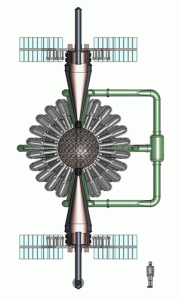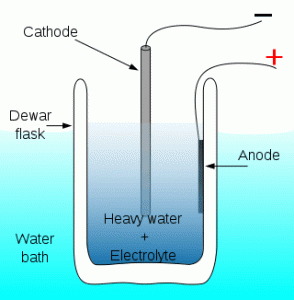General Fusion an Energy Breakthrough?
Can the dream become reality?

In an unassuming corner of Burnaby, a lush, green suburb of Vancouver, BC, I’ve arrived at the doorway of a company that could potentially change the world. But you’d never know it from the nondescript office park it’s situated in, or the bare bones furniture and office equipment I see once I open the door and announce my presence. It’s almost as if I’ve stepped back into the office of an insurance actuary circa 1973, right down to spartan wall decoration and all-male staff. Only the “General Fusion†sign on the door indicates anything out of the ordinary.
Source: Can Vancouver’s General Fusion Bring About an Energy Breakthrough?
Indeed, General Fusion is anything but ordinary. The startup is pouring brainpower, mechanical skill and sweat into building a low-tech but potentially revolutionary device capable of delivering virtually unlimited clean energy for the planet. And they plan to do it for far less than the billions of dollars governments have put into massive facilities that — even by conservative estimates — won’t produce a single unit of power for another couple of decades.
“So,†General Fusion CEO Doug Richardson says as he shows me into his office, “how much do you know about fusion?â€
Using fusion as an energy source has been alternately hyped, derided and discounted over the past 55 years, ever since the first H-Bomb burst over Bikini Atoll. The potential benefits of fusion are obvious: all you have to do is look up at the sun to see fusion at work. Every second of every day the sun generates fusion reactions, expelling enough energy to create a net gain of energy that keeps our planet alive. But creating that net gain from a fusion reaction here on Earth, in a safe and easily harnessed way, has confounded the best minds on the planet for more than half a century.
“Fusion is easy. Net gain is the hard part,†Richardson said.
WHAT IT IS
Nuclear fusion is the process where multiple like-charged atomic nuclei come together, or “fuse,†to create a heavier nucleus. Once this happens, energy is released.
Sounds simple, but like forces repulse each other, and in order for nuclei to fuse, they have to smash through substantial electrostatic forces known as the Coulomb barrier. The smallest Coulomb barrier occurs in hydrogen, which only has a single positive charge in its nucleus. But bi-protons aren’t stable, so fusion also uses neutrons, ideally from a helium nucleus. As a result, deuterium, also known as “heavy water†and which contains helium, makes an ideal fusion fuel. Richardson explains, “The problem is that heating things up is how you get energy, but nature doesn’t like things to be hot. Nature always tries to bring everything to equilibrium, and the sun is only able to sustain fusion because it is isolated in a vacuum.â€
Once you’ve started firing pellets of hydrogen at deuterium, you need someplace to contain the resulting release in energy in order to avoid the inevitable drift towards equilibrium and dissipation. Gravity makes an excellent containment field, but the only objects capable of generating that level of gravity are stars — and stars, obviously, are not an ideal environment for humans. Ions can be used to create a magnetic field, which keeps the resulting energy release from escaping. Liquid metal can also be used as a containment layer. “Think of a smoke ring,†Richardson explains. “If you squish that smoke ring fast enough, the energy can’t escape.â€
A SLAB IN THE LAB
At one point in our conversation, Richardson leads me to the back room where all the real work at General Fusion takes place. In the middle of the room, surrounded by large batteries and intense looking technicians, we are staring at the beginnings of a fusion reactor. The device measures about three meters end to end, and most closely resembles two oversized steel traffic pylons lying on their sides and pointing at each other. Eventually these pylons will be joined in the middle by a spherical chamber. I’m struck by both the small size of the prototype and the DIY aesthetic of the whole operation. Is this the energy source of the future, resting on wooden blocks?
When the general public thinks of fusion, giant donut-shaped devices commonly spring to mind. These devices, known as tokamaks, are essentially giant magnets built to contain high-speed fusion reactions. These magnets and all the associated staff, equipment and maintenance are astronomically expensive. The usefulness of this kind of magnetic fusion is limited, since it can’t be easily adapted for use in power plants. Lasers can also be used to generate an implosion, but that’s an equally expensive proposition. Richardson: “Lasers are high tech, and the magnetic guys are even more high tech. But high tech is expensive. What we want to do is take old stuff and put it together.â€
General Fusion’s reactor is a metal sphere surrounded by pneumatic pistons. The pistons create an acoustic wave that travels through a liquid metal containment layer, hitting the center with a shock wave. In the center of the sphere, a plasma target should then — in theory — implode and create fusion energy, which is then extracted with a heat exchanger. From there, steam is released to create electricity. For the reactor to have any practical purpose, it has to repeat this process every second.
General Fusion is currently in the first stage of the project, building all the components including the sphere that will eventually contain a magnetized ball of plasma. During the second stage, due to start in 2011, they’ll build the actual reactor.
Richardson isn’t talking about incrementally lowering the cost of fusion. He’s talking about a quantum leap downward in price. The company hasn’t yet reached their stated goal of raising $50 million, a pittance compared to the money spent on government funded fusion projects, but has succeeded in raising over $9 million from private investors and $12.9 million from Sustainable Technology Development Canada, a Canadian government agency.
Where GF innovates is in adapting today’s technology to improve an old design. Fusion energy is generated in miniscule amounts of time, and thirty years ago the technology simply wasn’t available to control instruments fast enough to take control during the crucial moment when fusion energy is released.
But in 2009, we have fast and cheap computer chips that offer very precise control over motors that can create compressive forces in mere microseconds. “We got to the point in the ’70s and ’80s that we could get plasma to last milliseconds. The question was how to control it. Now, with cheap digital signal processors,†at this point Richardson points at my iPhone, “it can be done.â€
And it only has to be done once. If General Fusion can prove they’ve produced net gain through fusion, the world will beat a path to their door. “The next stage would be to build a reactor at the same scale, but with the ability to reliably produce energy at a rate of once every thousand seconds. From there fusion will eventually scale up into power plants, a development Richardson estimates will cost upwards of $1 billion, but it will be a cost born by industries who will benefit immensely from the potential benefits of fusion power. Richardson: “If you look at the scale of spending on energy research and development, $50 million is peanuts. The oil and gas industry spends $20 billion to develop and deploy technology in the Alberta tar sands right now.â€
BAD REP: THE PONS SCHEME
Technical and scientific challenges are only part of the long uphill climb faced by companies working on developing fusion. There is also public skepticism. A lack of tangible results, even after decades of work and billions of dollars, has left fusion with a reputation for, in Richardson’s words, being “30 years away for the past 30 years.â€

Perhaps the lowest ebb for fusion’s public reputation was the infamous Fleischmann-Pons announcement in 1989. University of Southampton researcher Martin Fleischmann and University of Utah researcher Stanley Pons stunned the world when they claimed they had produced excess heat during the electrolysis of heavy water on a palladium electrode. The magnitude of the heat production was high enough that they said it could only be explained as a nuclear process. When the two researchers couldn’t reproduce their experiment, fusion earned a black eye that it still hasn’t fully recovered from.
General Fusion has to face a general pubic that is at best apathetic and at worst dismissive. But that’s not all. Because they’re attempting something no one else has been able to achieve, and doing it on the cheap, they run into an equal amount of skepticism within the fusion community itself. Many fusion projects are mammoth undertakings funded with billions of dollars of government money. Each project requires hundreds of scientists and technicians — all smart people who, after several decades, still can’t produce a controllable fusion reaction. When a startup like General Fusion decides it will tackle fusion from a small space in the middle of suburban Vancouver, the default position of many in the fusion establishment is negative.
Richardson sighs: “There’s a feeling that the research has to be done by a government, that it costs billions of dollars and that 3,000 smart people can’t be wrong. People have a mindset that this can’t be done by a small company, and overall I’m disappointed with that attitude. Those involved in science should be curious, but it’s easier to just dismiss us.†Unlike the discredited cold fusion experiments and even the “legitimate†fusion researchers, General Fusion isn’t interested in discovering anything. In fact, they’re going out of their way to stick to what they know. “We’re boring,†Richardson says. “This is basic stuff, and all we’re doing is taking other people’s ideas and going down a path that no one has taken yet,†Richardson said.
WORLD CHANGER
Boring? Maybe. But the benefits from controlled fusion will be anything but boring. While Richardson cautions that it makes little sense to power a car or other small devices via fusion, power plants and other large scale projects do make sense, and would be much more environmentally sound than current coal-fired electrical plants. Richardson: “You can buy an electric car today, but all that does is created ’distributed pollution.’ For that car to run, at some point someone had to burn coal.†With fusion, which runs off tanks of heavy water, no such pollution is created. “Electric plants in the united States take three trainloads of coal a day, but you could run a fusion reactor with one truckload of heavy water for a year,†he said.
And while he says that current spacecraft designs aren’t well suited for fusion engines, it’s important to remember how low on the developmental curve we currently reside. “When the Wright Brothers flew their plane in 1903, no one could predict 747s only 60 years later, or planes breaking the speed of sound. We didn’t even know what metal fatigue was until we had planes regularly flying in the air. When man wants to innovate, it will happen. Fusion will evolve, and it will be cheaper, faster, and better,†he said.
But right now, the staff is gathered around their ragtag collection of batteries and fuses watching an oscilloscope as they test a switch. And as I leave the office, I get the feeling that I know what people who walked out of Apple’s formative garage or the Google founder’s dorm rooms must have felt like. The future may be lying in partially assembled pieces in Vancouver, just waiting to be put together and switched on, so it can change the world.

Leave a Reply
Want to join the discussion?Feel free to contribute!